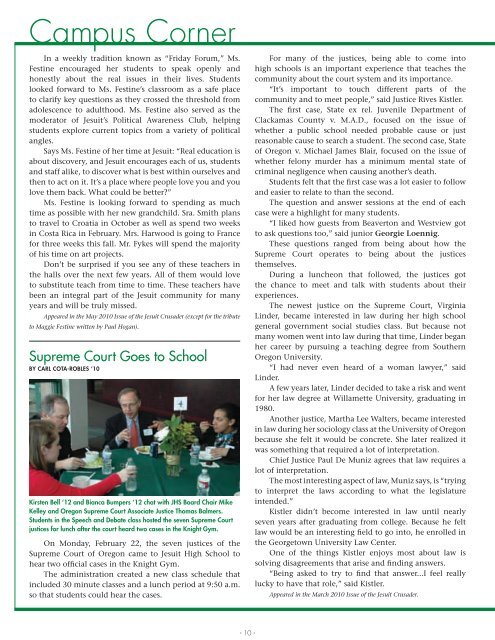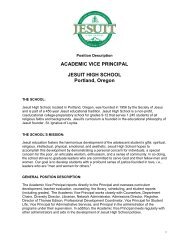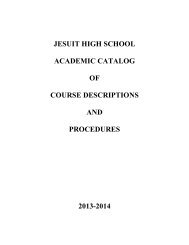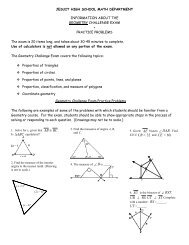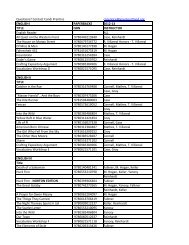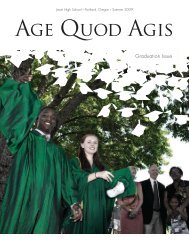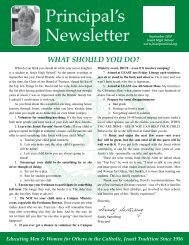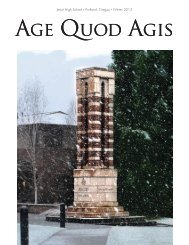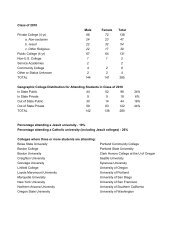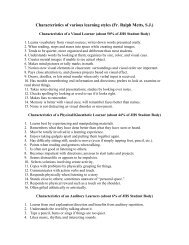Age Quod Agis - Jesuit High School
Age Quod Agis - Jesuit High School
Age Quod Agis - Jesuit High School
You also want an ePaper? Increase the reach of your titles
YUMPU automatically turns print PDFs into web optimized ePapers that Google loves.
Campus Corner<br />
In a weekly tradition known as “Friday Forum,” Ms.<br />
Festine encouraged her students to speak openly and<br />
honestly about the real issues in their lives. Students<br />
looked forward to Ms. Festine’s classroom as a safe place<br />
to clarify key questions as they crossed the threshold from<br />
adolescence to adulthood. Ms. Festine also served as the<br />
moderator of <strong>Jesuit</strong>’s Political Awareness Club, helping<br />
students explore current topics from a variety of political<br />
angles.<br />
Says Ms. Festine of her time at <strong>Jesuit</strong>: “Real education is<br />
about discovery, and <strong>Jesuit</strong> encourages each of us, students<br />
and staff alike, to discover what is best within ourselves and<br />
then to act on it. It’s a place where people love you and you<br />
love them back. What could be better?”<br />
Ms. Festine is looking forward to spending as much<br />
time as possible with her new grandchild. Sra. Smith plans<br />
to travel to Croatia in October as well as spend two weeks<br />
in Costa Rica in February. Mrs. Harwood is going to France<br />
for three weeks this fall. Mr. Fykes will spend the majority<br />
of his time on art projects.<br />
Don’t be surprised if you see any of these teachers in<br />
the halls over the next few years. All of them would love<br />
to substitute teach from time to time. These teachers have<br />
been an integral part of the <strong>Jesuit</strong> community for many<br />
years and will be truly missed.<br />
Appeared in the May 2010 Issue of the <strong>Jesuit</strong> Crusader (except for the tribute<br />
to Maggie Festine written by Paul Hogan).<br />
Supreme Court Goes to <strong>School</strong><br />
BY CArL COTA-rOBLeS ‘10<br />
Kirsten Bell ‘12 and Bianca Bumpers ‘12 chat with JHS Board Chair mike<br />
Kelley and Oregon Supreme Court Associate Justice Thomas Balmers.<br />
Students in the Speech and Debate class hosted the seven Supreme Court<br />
justices for lunch after the court heard two cases in the Knight Gym.<br />
On Monday, February 22, the seven justices of the<br />
Supreme Court of Oregon came to <strong>Jesuit</strong> <strong>High</strong> <strong>School</strong> to<br />
hear two official cases in the Knight Gym.<br />
The administration created a new class schedule that<br />
included 30 minute classes and a lunch period at 9:50 a.m.<br />
so that students could hear the cases.<br />
• 10 •<br />
For many of the justices, being able to come into<br />
high schools is an important experience that teaches the<br />
community about the court system and its importance.<br />
“It’s important to touch different parts of the<br />
community and to meet people,” said Justice Rives Kistler.<br />
The first case, State ex rel. Juvenile Department of<br />
Clackamas County v. M.A.D., focused on the issue of<br />
whether a public school needed probable cause or just<br />
reasonable cause to search a student. The second case, State<br />
of Oregon v. Michael James Blair, focused on the issue of<br />
whether felony murder has a minimum mental state of<br />
criminal negligence when causing another’s death.<br />
Students felt that the first case was a lot easier to follow<br />
and easier to relate to than the second.<br />
The question and answer sessions at the end of each<br />
case were a highlight for many students.<br />
“I liked how guests from Beaverton and Westview got<br />
to ask questions too,” said junior Georgie Loennig.<br />
These questions ranged from being about how the<br />
Supreme Court operates to being about the justices<br />
themselves.<br />
During a luncheon that followed, the justices got<br />
the chance to meet and talk with students about their<br />
experiences.<br />
The newest justice on the Supreme Court, Virginia<br />
Linder, became interested in law during her high school<br />
general government social studies class. But because not<br />
many women went into law during that time, Linder began<br />
her career by pursuing a teaching degree from Southern<br />
Oregon University.<br />
“I had never even heard of a woman lawyer,” said<br />
Linder.<br />
A few years later, Linder decided to take a risk and went<br />
for her law degree at Willamette University, graduating in<br />
1980.<br />
Another justice, Martha Lee Walters, became interested<br />
in law during her sociology class at the University of Oregon<br />
because she felt it would be concrete. She later realized it<br />
was something that required a lot of interpretation.<br />
Chief Justice Paul De Muniz agrees that law requires a<br />
lot of interpretation.<br />
The most interesting aspect of law, Muniz says, is “trying<br />
to interpret the laws according to what the legislature<br />
intended.”<br />
Kistler didn’t become interested in law until nearly<br />
seven years after graduating from college. Because he felt<br />
law would be an interesting field to go into, he enrolled in<br />
the Georgetown University Law Center.<br />
One of the things Kistler enjoys most about law is<br />
solving disagreements that arise and finding answers.<br />
“Being asked to try to find that answer...I feel really<br />
lucky to have that role,” said Kistler.<br />
Appeared in the March 2010 Issue of the <strong>Jesuit</strong> Crusader.


